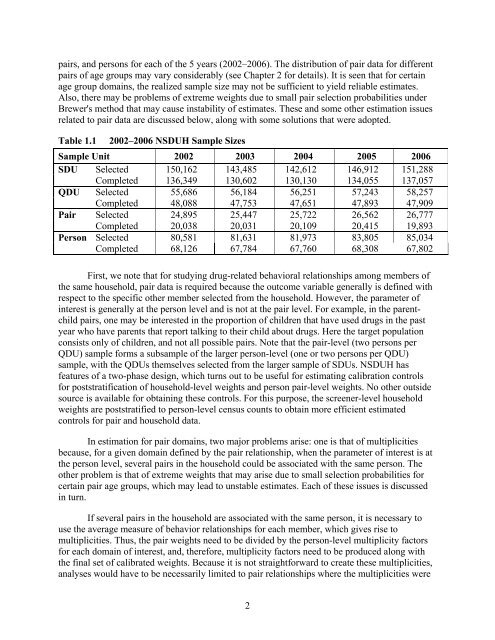Questionnaire Dwelling Unit-Level and Person Pair-Level Sampling ...
Questionnaire Dwelling Unit-Level and Person Pair-Level Sampling ...
Questionnaire Dwelling Unit-Level and Person Pair-Level Sampling ...
You also want an ePaper? Increase the reach of your titles
YUMPU automatically turns print PDFs into web optimized ePapers that Google loves.
pairs, <strong>and</strong> persons for each of the 5 years (2002–2006). The distribution of pair data for different<br />
pairs of age groups may vary considerably (see Chapter 2 for details). It is seen that for certain<br />
age group domains, the realized sample size may not be sufficient to yield reliable estimates.<br />
Also, there may be problems of extreme weights due to small pair selection probabilities under<br />
Brewer's method that may cause instability of estimates. These <strong>and</strong> some other estimation issues<br />
related to pair data are discussed below, along with some solutions that were adopted.<br />
Table 1.1 2002–2006 NSDUH Sample Sizes<br />
Sample <strong>Unit</strong> 2002 2003 2004 2005 2006<br />
SDU Selected 150,162 143,485 142,612 146,912 151,288<br />
Completed 136,349 130,602 130,130 134,055 137,057<br />
QDU Selected 55,686 56,184 56,251 57,243 58,257<br />
Completed 48,088 47,753 47,651 47,893 47,909<br />
<strong>Pair</strong> Selected 24,895 25,447 25,722 26,562 26,777<br />
Completed 20,038 20,031 20,109 20,415 19,893<br />
<strong>Person</strong> Selected 80,581 81,631 81,973 83,805 85,034<br />
Completed 68,126 67,784 67,760 68,308 67,802<br />
First, we note that for studying drug-related behavioral relationships among members of<br />
the same household, pair data is required because the outcome variable generally is defined with<br />
respect to the specific other member selected from the household. However, the parameter of<br />
interest is generally at the person level <strong>and</strong> is not at the pair level. For example, in the parentchild<br />
pairs, one may be interested in the proportion of children that have used drugs in the past<br />
year who have parents that report talking to their child about drugs. Here the target population<br />
consists only of children, <strong>and</strong> not all possible pairs. Note that the pair-level (two persons per<br />
QDU) sample forms a subsample of the larger person-level (one or two persons per QDU)<br />
sample, with the QDUs themselves selected from the larger sample of SDUs. NSDUH has<br />
features of a two-phase design, which turns out to be useful for estimating calibration controls<br />
for poststratification of household-level weights <strong>and</strong> person pair-level weights. No other outside<br />
source is available for obtaining these controls. For this purpose, the screener-level household<br />
weights are poststratified to person-level census counts to obtain more efficient estimated<br />
controls for pair <strong>and</strong> household data.<br />
In estimation for pair domains, two major problems arise: one is that of multiplicities<br />
because, for a given domain defined by the pair relationship, when the parameter of interest is at<br />
the person level, several pairs in the household could be associated with the same person. The<br />
other problem is that of extreme weights that may arise due to small selection probabilities for<br />
certain pair age groups, which may lead to unstable estimates. Each of these issues is discussed<br />
in turn.<br />
If several pairs in the household are associated with the same person, it is necessary to<br />
use the average measure of behavior relationships for each member, which gives rise to<br />
multiplicities. Thus, the pair weights need to be divided by the person-level multiplicity factors<br />
for each domain of interest, <strong>and</strong>, therefore, multiplicity factors need to be produced along with<br />
the final set of calibrated weights. Because it is not straightforward to create these multiplicities,<br />
analyses would have to be necessarily limited to pair relationships where the multiplicities were<br />
2
















